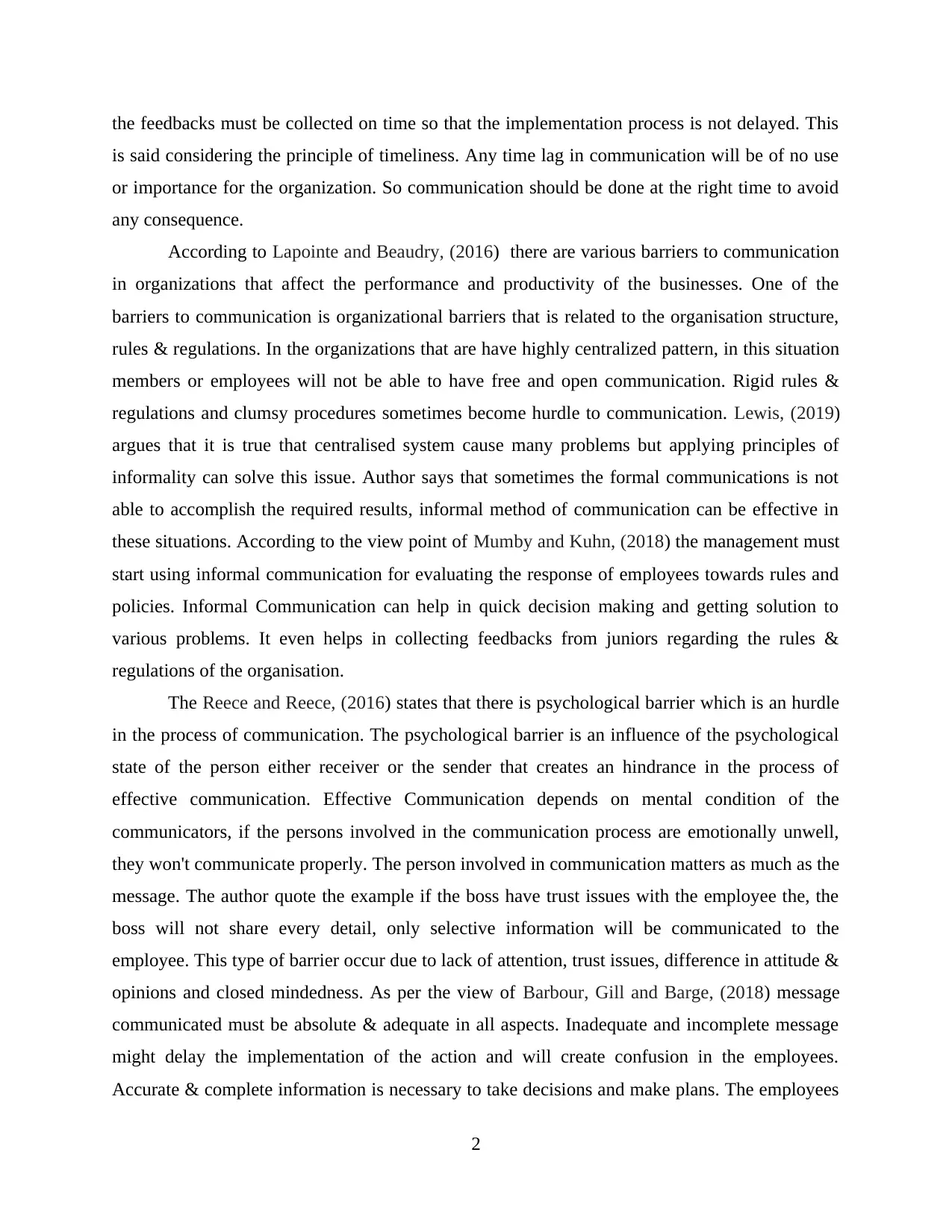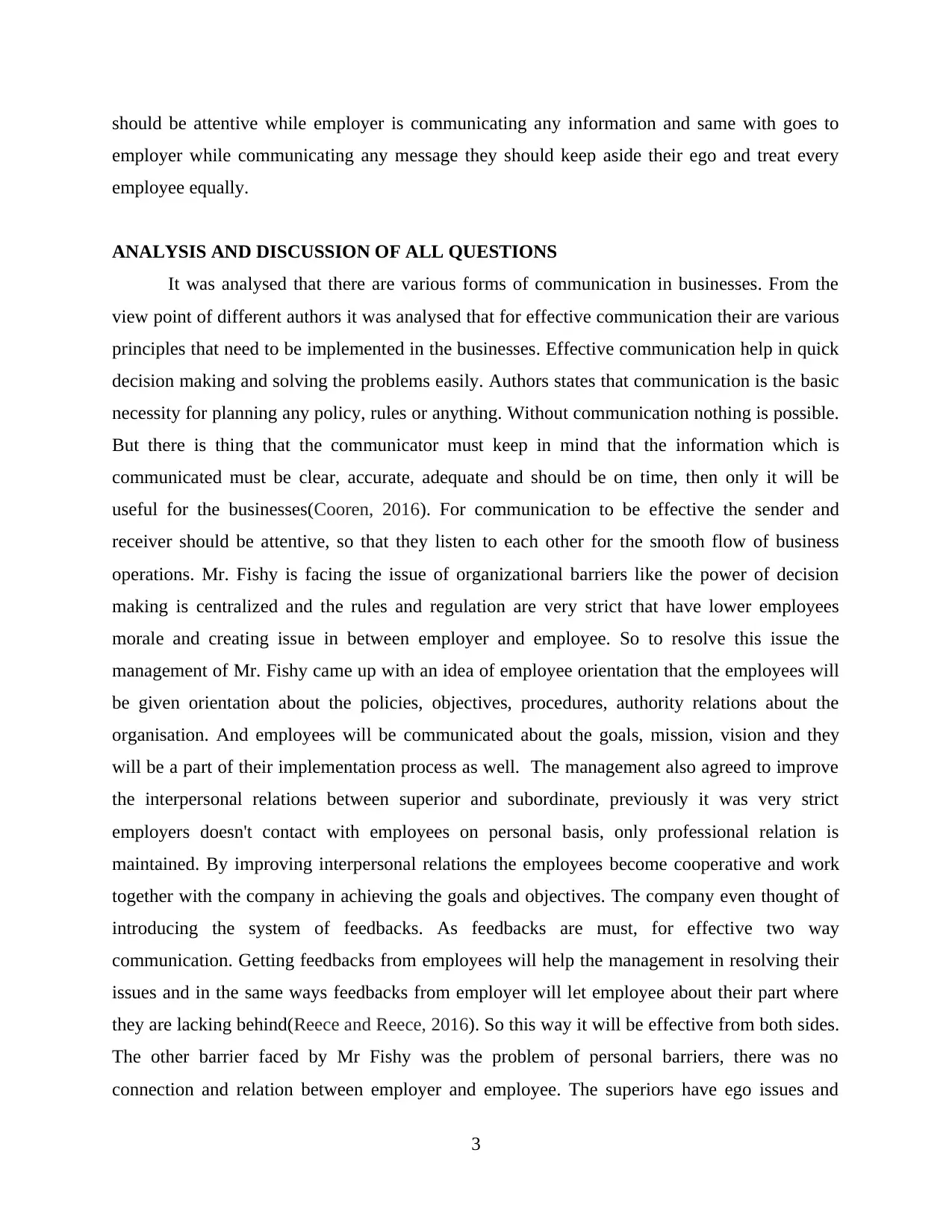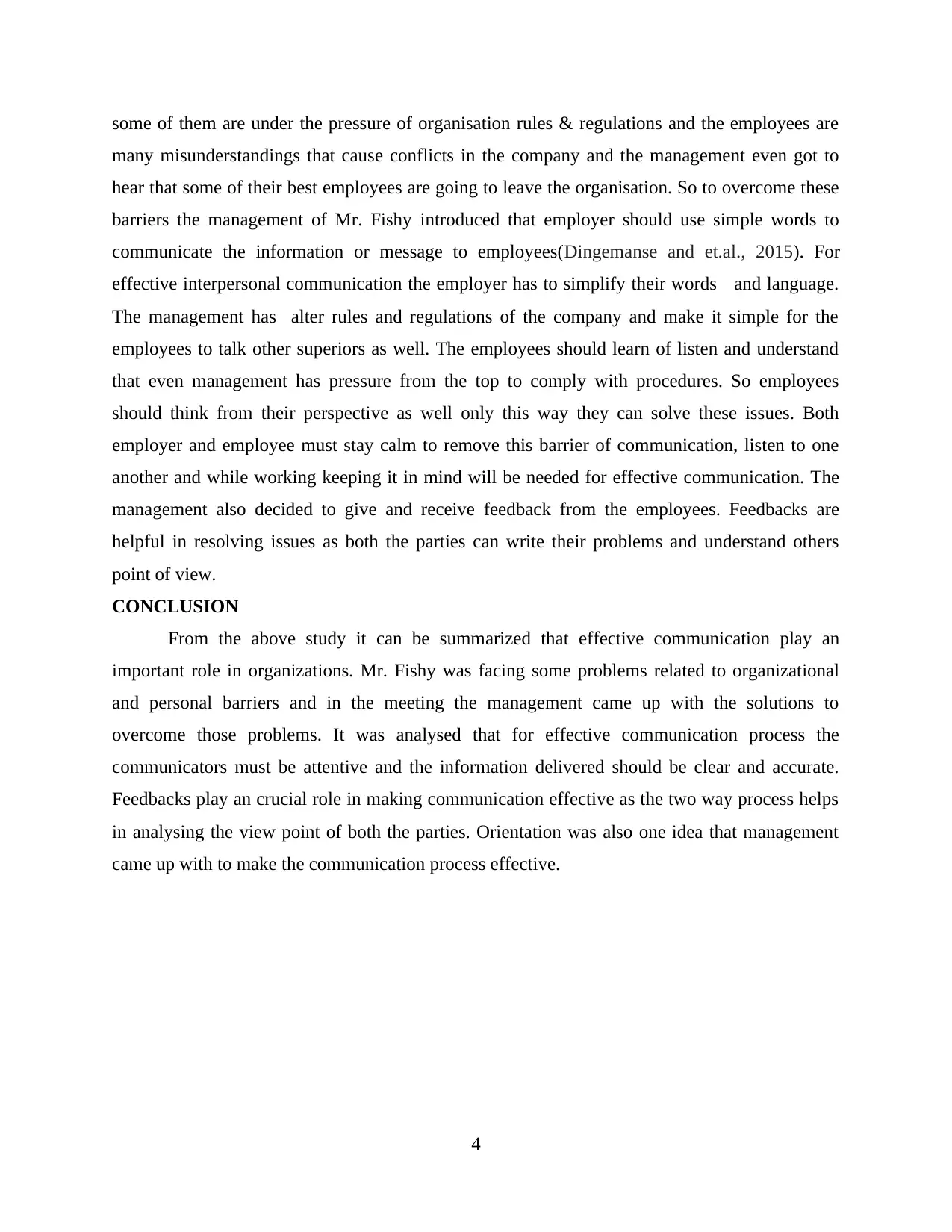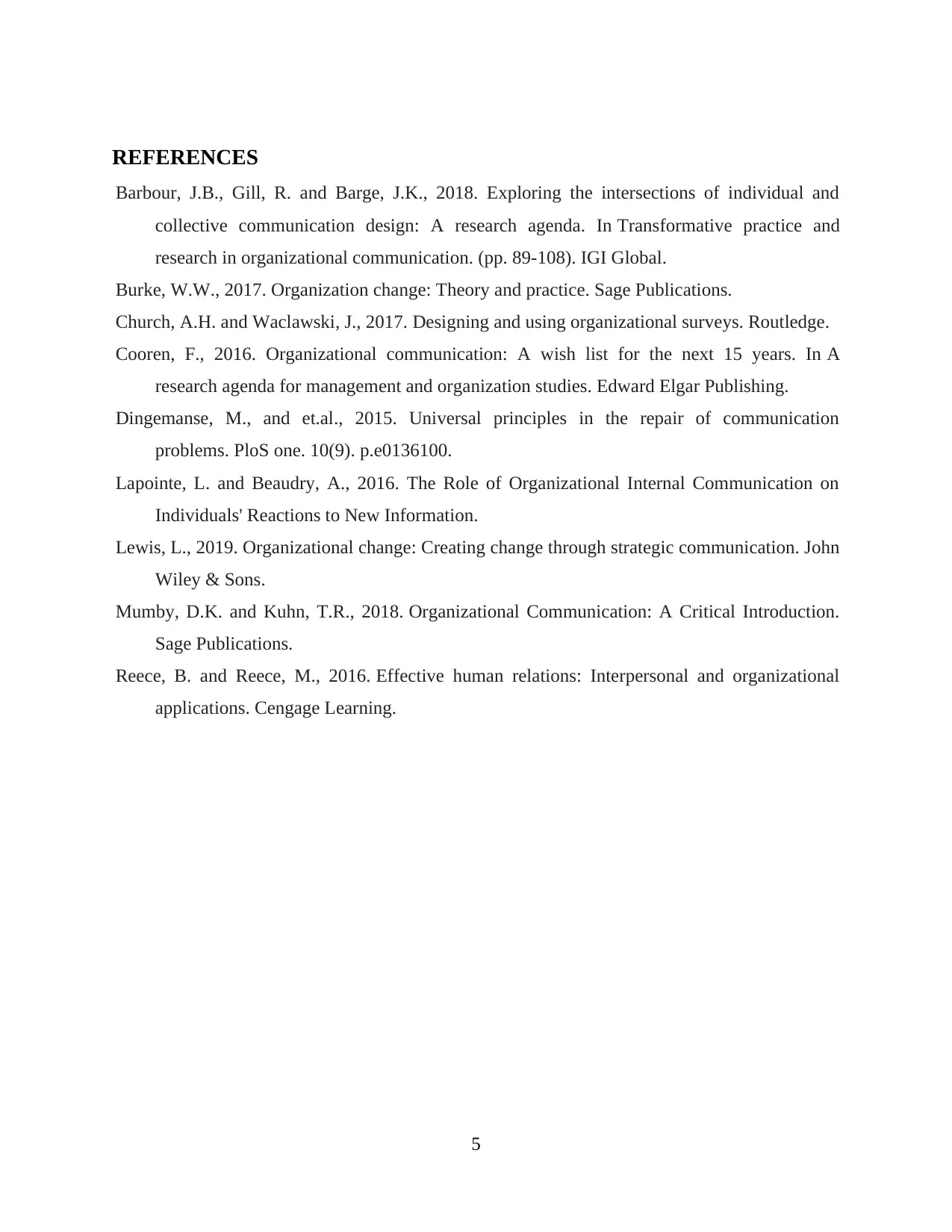Analyzing Organizational Communication at Mr. Fishy: A Detailed Report
VerifiedAdded on 2021/02/19
|11
|1941
|384
Report
AI Summary
This report analyzes the organizational communication practices and strategies implemented at Mr. Fishy to address communication challenges and barriers. The report begins with an introduction to organizational communication, followed by a literature review exploring various forms of communication, including formal, informal, downward, upward, horizontal, written, oral, and verbal communication. The literature review also discusses communication principles, such as clarity, timeliness, and feedback, and examines organizational and psychological barriers to effective communication. The report then analyzes the specific communication challenges faced by Mr. Fishy, including centralized decision-making, strict rules, and poor interpersonal relations. Based on the analysis, the report proposes solutions such as employee orientation programs, improved interpersonal relations between superiors and subordinates, and the implementation of feedback systems. The report concludes by summarizing the key findings and emphasizing the importance of effective communication in organizations. The report references several academic sources to support its analysis and recommendations.

REPORT
Paraphrase This Document
Need a fresh take? Get an instant paraphrase of this document with our AI Paraphraser

Table of Contents
INTRODUCTION...........................................................................................................................1
LITERATURE REVIEW ..............................................................................................................1
ANALYSIS AND DISCUSSION OF ALL QUESTIONS.............................................................3
CONCLUSION ..............................................................................................................................4
REFERENCES................................................................................................................................5
INTRODUCTION...........................................................................................................................1
LITERATURE REVIEW ..............................................................................................................1
ANALYSIS AND DISCUSSION OF ALL QUESTIONS.............................................................3
CONCLUSION ..............................................................................................................................4
REFERENCES................................................................................................................................5

INTRODUCTION
Organizational Communication refers to the exchange of views, information & ideas that
is both within and outside the business. Every business whether profitable or a non profitable
organization has specific objectives & stakeholders. So to achieve those goals and objectives
effective communication is must with the stakeholders of the company. The report will highlight
about the communication practices and strategies that will be applied in Mr. Fishy to overcome
the challenges & barriers faced by them(Barbour, Gill and Barge, 2018). The report also
describes the principles of various forms of communication and how these principles will be
applied for effective communication at Mr. Fishy.
LITERATURE REVIEW
According to Burke, (2017) Organizational communication means the flow of
information inside and outside the network of business. There are various forms of
organizational communication depending on the structure, direction & expression such as
formal, informal, downward, upward, horizontal, written, oral and verbal. The author states that
communication is the base for action. Any activity starts with communicating the necessary
information to the members. Communications makes planning easy like passing any information
for the requirement in the company. But there should be clarity in what the individual wants to
communicate, then only it will be effective. The message should be clearly communicated to the
other person. On the other hand Church and Waclawski, (2017) states that sometimes there is
clarity in the message of the sender but still the receiver due to lack of attention misinterpret the
information that can lead to either loss of profits or any misunderstanding between the receiver
and sender of the information. So for communication to be effective it must be clear and the
receiver should be attentive.
As per the view of Cooren, (2016) Communication is the medium of information for the
organizational members and helps them in decision making process. For decisions to be effective
there should be smooth flow of communication in the organization. In this manner the decision
makers have idea that the decisions they have made has take every person's consideration and
includes all the relevant facts. This is according to the principle of feedback that to make
communication effective it is necessary to get feedbacks from every person in the organization.
As individuals can reply to the information forwarded to them and state their views regarding the
same and organization will consider it. On the contrary Dingemanse and et.al., (2015) says that
1
Organizational Communication refers to the exchange of views, information & ideas that
is both within and outside the business. Every business whether profitable or a non profitable
organization has specific objectives & stakeholders. So to achieve those goals and objectives
effective communication is must with the stakeholders of the company. The report will highlight
about the communication practices and strategies that will be applied in Mr. Fishy to overcome
the challenges & barriers faced by them(Barbour, Gill and Barge, 2018). The report also
describes the principles of various forms of communication and how these principles will be
applied for effective communication at Mr. Fishy.
LITERATURE REVIEW
According to Burke, (2017) Organizational communication means the flow of
information inside and outside the network of business. There are various forms of
organizational communication depending on the structure, direction & expression such as
formal, informal, downward, upward, horizontal, written, oral and verbal. The author states that
communication is the base for action. Any activity starts with communicating the necessary
information to the members. Communications makes planning easy like passing any information
for the requirement in the company. But there should be clarity in what the individual wants to
communicate, then only it will be effective. The message should be clearly communicated to the
other person. On the other hand Church and Waclawski, (2017) states that sometimes there is
clarity in the message of the sender but still the receiver due to lack of attention misinterpret the
information that can lead to either loss of profits or any misunderstanding between the receiver
and sender of the information. So for communication to be effective it must be clear and the
receiver should be attentive.
As per the view of Cooren, (2016) Communication is the medium of information for the
organizational members and helps them in decision making process. For decisions to be effective
there should be smooth flow of communication in the organization. In this manner the decision
makers have idea that the decisions they have made has take every person's consideration and
includes all the relevant facts. This is according to the principle of feedback that to make
communication effective it is necessary to get feedbacks from every person in the organization.
As individuals can reply to the information forwarded to them and state their views regarding the
same and organization will consider it. On the contrary Dingemanse and et.al., (2015) says that
1
⊘ This is a preview!⊘
Do you want full access?
Subscribe today to unlock all pages.

Trusted by 1+ million students worldwide

the feedbacks must be collected on time so that the implementation process is not delayed. This
is said considering the principle of timeliness. Any time lag in communication will be of no use
or importance for the organization. So communication should be done at the right time to avoid
any consequence.
According to Lapointe and Beaudry, (2016) there are various barriers to communication
in organizations that affect the performance and productivity of the businesses. One of the
barriers to communication is organizational barriers that is related to the organisation structure,
rules & regulations. In the organizations that are have highly centralized pattern, in this situation
members or employees will not be able to have free and open communication. Rigid rules &
regulations and clumsy procedures sometimes become hurdle to communication. Lewis, (2019)
argues that it is true that centralised system cause many problems but applying principles of
informality can solve this issue. Author says that sometimes the formal communications is not
able to accomplish the required results, informal method of communication can be effective in
these situations. According to the view point of Mumby and Kuhn, (2018) the management must
start using informal communication for evaluating the response of employees towards rules and
policies. Informal Communication can help in quick decision making and getting solution to
various problems. It even helps in collecting feedbacks from juniors regarding the rules &
regulations of the organisation.
The Reece and Reece, (2016) states that there is psychological barrier which is an hurdle
in the process of communication. The psychological barrier is an influence of the psychological
state of the person either receiver or the sender that creates an hindrance in the process of
effective communication. Effective Communication depends on mental condition of the
communicators, if the persons involved in the communication process are emotionally unwell,
they won't communicate properly. The person involved in communication matters as much as the
message. The author quote the example if the boss have trust issues with the employee the, the
boss will not share every detail, only selective information will be communicated to the
employee. This type of barrier occur due to lack of attention, trust issues, difference in attitude &
opinions and closed mindedness. As per the view of Barbour, Gill and Barge, (2018) message
communicated must be absolute & adequate in all aspects. Inadequate and incomplete message
might delay the implementation of the action and will create confusion in the employees.
Accurate & complete information is necessary to take decisions and make plans. The employees
2
is said considering the principle of timeliness. Any time lag in communication will be of no use
or importance for the organization. So communication should be done at the right time to avoid
any consequence.
According to Lapointe and Beaudry, (2016) there are various barriers to communication
in organizations that affect the performance and productivity of the businesses. One of the
barriers to communication is organizational barriers that is related to the organisation structure,
rules & regulations. In the organizations that are have highly centralized pattern, in this situation
members or employees will not be able to have free and open communication. Rigid rules &
regulations and clumsy procedures sometimes become hurdle to communication. Lewis, (2019)
argues that it is true that centralised system cause many problems but applying principles of
informality can solve this issue. Author says that sometimes the formal communications is not
able to accomplish the required results, informal method of communication can be effective in
these situations. According to the view point of Mumby and Kuhn, (2018) the management must
start using informal communication for evaluating the response of employees towards rules and
policies. Informal Communication can help in quick decision making and getting solution to
various problems. It even helps in collecting feedbacks from juniors regarding the rules &
regulations of the organisation.
The Reece and Reece, (2016) states that there is psychological barrier which is an hurdle
in the process of communication. The psychological barrier is an influence of the psychological
state of the person either receiver or the sender that creates an hindrance in the process of
effective communication. Effective Communication depends on mental condition of the
communicators, if the persons involved in the communication process are emotionally unwell,
they won't communicate properly. The person involved in communication matters as much as the
message. The author quote the example if the boss have trust issues with the employee the, the
boss will not share every detail, only selective information will be communicated to the
employee. This type of barrier occur due to lack of attention, trust issues, difference in attitude &
opinions and closed mindedness. As per the view of Barbour, Gill and Barge, (2018) message
communicated must be absolute & adequate in all aspects. Inadequate and incomplete message
might delay the implementation of the action and will create confusion in the employees.
Accurate & complete information is necessary to take decisions and make plans. The employees
2
Paraphrase This Document
Need a fresh take? Get an instant paraphrase of this document with our AI Paraphraser

should be attentive while employer is communicating any information and same with goes to
employer while communicating any message they should keep aside their ego and treat every
employee equally.
ANALYSIS AND DISCUSSION OF ALL QUESTIONS
It was analysed that there are various forms of communication in businesses. From the
view point of different authors it was analysed that for effective communication their are various
principles that need to be implemented in the businesses. Effective communication help in quick
decision making and solving the problems easily. Authors states that communication is the basic
necessity for planning any policy, rules or anything. Without communication nothing is possible.
But there is thing that the communicator must keep in mind that the information which is
communicated must be clear, accurate, adequate and should be on time, then only it will be
useful for the businesses(Cooren, 2016). For communication to be effective the sender and
receiver should be attentive, so that they listen to each other for the smooth flow of business
operations. Mr. Fishy is facing the issue of organizational barriers like the power of decision
making is centralized and the rules and regulation are very strict that have lower employees
morale and creating issue in between employer and employee. So to resolve this issue the
management of Mr. Fishy came up with an idea of employee orientation that the employees will
be given orientation about the policies, objectives, procedures, authority relations about the
organisation. And employees will be communicated about the goals, mission, vision and they
will be a part of their implementation process as well. The management also agreed to improve
the interpersonal relations between superior and subordinate, previously it was very strict
employers doesn't contact with employees on personal basis, only professional relation is
maintained. By improving interpersonal relations the employees become cooperative and work
together with the company in achieving the goals and objectives. The company even thought of
introducing the system of feedbacks. As feedbacks are must, for effective two way
communication. Getting feedbacks from employees will help the management in resolving their
issues and in the same ways feedbacks from employer will let employee about their part where
they are lacking behind(Reece and Reece, 2016). So this way it will be effective from both sides.
The other barrier faced by Mr Fishy was the problem of personal barriers, there was no
connection and relation between employer and employee. The superiors have ego issues and
3
employer while communicating any message they should keep aside their ego and treat every
employee equally.
ANALYSIS AND DISCUSSION OF ALL QUESTIONS
It was analysed that there are various forms of communication in businesses. From the
view point of different authors it was analysed that for effective communication their are various
principles that need to be implemented in the businesses. Effective communication help in quick
decision making and solving the problems easily. Authors states that communication is the basic
necessity for planning any policy, rules or anything. Without communication nothing is possible.
But there is thing that the communicator must keep in mind that the information which is
communicated must be clear, accurate, adequate and should be on time, then only it will be
useful for the businesses(Cooren, 2016). For communication to be effective the sender and
receiver should be attentive, so that they listen to each other for the smooth flow of business
operations. Mr. Fishy is facing the issue of organizational barriers like the power of decision
making is centralized and the rules and regulation are very strict that have lower employees
morale and creating issue in between employer and employee. So to resolve this issue the
management of Mr. Fishy came up with an idea of employee orientation that the employees will
be given orientation about the policies, objectives, procedures, authority relations about the
organisation. And employees will be communicated about the goals, mission, vision and they
will be a part of their implementation process as well. The management also agreed to improve
the interpersonal relations between superior and subordinate, previously it was very strict
employers doesn't contact with employees on personal basis, only professional relation is
maintained. By improving interpersonal relations the employees become cooperative and work
together with the company in achieving the goals and objectives. The company even thought of
introducing the system of feedbacks. As feedbacks are must, for effective two way
communication. Getting feedbacks from employees will help the management in resolving their
issues and in the same ways feedbacks from employer will let employee about their part where
they are lacking behind(Reece and Reece, 2016). So this way it will be effective from both sides.
The other barrier faced by Mr Fishy was the problem of personal barriers, there was no
connection and relation between employer and employee. The superiors have ego issues and
3

some of them are under the pressure of organisation rules & regulations and the employees are
many misunderstandings that cause conflicts in the company and the management even got to
hear that some of their best employees are going to leave the organisation. So to overcome these
barriers the management of Mr. Fishy introduced that employer should use simple words to
communicate the information or message to employees(Dingemanse and et.al., 2015). For
effective interpersonal communication the employer has to simplify their words and language.
The management has alter rules and regulations of the company and make it simple for the
employees to talk other superiors as well. The employees should learn of listen and understand
that even management has pressure from the top to comply with procedures. So employees
should think from their perspective as well only this way they can solve these issues. Both
employer and employee must stay calm to remove this barrier of communication, listen to one
another and while working keeping it in mind will be needed for effective communication. The
management also decided to give and receive feedback from the employees. Feedbacks are
helpful in resolving issues as both the parties can write their problems and understand others
point of view.
CONCLUSION
From the above study it can be summarized that effective communication play an
important role in organizations. Mr. Fishy was facing some problems related to organizational
and personal barriers and in the meeting the management came up with the solutions to
overcome those problems. It was analysed that for effective communication process the
communicators must be attentive and the information delivered should be clear and accurate.
Feedbacks play an crucial role in making communication effective as the two way process helps
in analysing the view point of both the parties. Orientation was also one idea that management
came up with to make the communication process effective.
4
many misunderstandings that cause conflicts in the company and the management even got to
hear that some of their best employees are going to leave the organisation. So to overcome these
barriers the management of Mr. Fishy introduced that employer should use simple words to
communicate the information or message to employees(Dingemanse and et.al., 2015). For
effective interpersonal communication the employer has to simplify their words and language.
The management has alter rules and regulations of the company and make it simple for the
employees to talk other superiors as well. The employees should learn of listen and understand
that even management has pressure from the top to comply with procedures. So employees
should think from their perspective as well only this way they can solve these issues. Both
employer and employee must stay calm to remove this barrier of communication, listen to one
another and while working keeping it in mind will be needed for effective communication. The
management also decided to give and receive feedback from the employees. Feedbacks are
helpful in resolving issues as both the parties can write their problems and understand others
point of view.
CONCLUSION
From the above study it can be summarized that effective communication play an
important role in organizations. Mr. Fishy was facing some problems related to organizational
and personal barriers and in the meeting the management came up with the solutions to
overcome those problems. It was analysed that for effective communication process the
communicators must be attentive and the information delivered should be clear and accurate.
Feedbacks play an crucial role in making communication effective as the two way process helps
in analysing the view point of both the parties. Orientation was also one idea that management
came up with to make the communication process effective.
4
⊘ This is a preview!⊘
Do you want full access?
Subscribe today to unlock all pages.

Trusted by 1+ million students worldwide

REFERENCES
Barbour, J.B., Gill, R. and Barge, J.K., 2018. Exploring the intersections of individual and
collective communication design: A research agenda. In Transformative practice and
research in organizational communication. (pp. 89-108). IGI Global.
Burke, W.W., 2017. Organization change: Theory and practice. Sage Publications.
Church, A.H. and Waclawski, J., 2017. Designing and using organizational surveys. Routledge.
Cooren, F., 2016. Organizational communication: A wish list for the next 15 years. In A
research agenda for management and organization studies. Edward Elgar Publishing.
Dingemanse, M., and et.al., 2015. Universal principles in the repair of communication
problems. PloS one. 10(9). p.e0136100.
Lapointe, L. and Beaudry, A., 2016. The Role of Organizational Internal Communication on
Individuals' Reactions to New Information.
Lewis, L., 2019. Organizational change: Creating change through strategic communication. John
Wiley & Sons.
Mumby, D.K. and Kuhn, T.R., 2018. Organizational Communication: A Critical Introduction.
Sage Publications.
Reece, B. and Reece, M., 2016. Effective human relations: Interpersonal and organizational
applications. Cengage Learning.
5
Barbour, J.B., Gill, R. and Barge, J.K., 2018. Exploring the intersections of individual and
collective communication design: A research agenda. In Transformative practice and
research in organizational communication. (pp. 89-108). IGI Global.
Burke, W.W., 2017. Organization change: Theory and practice. Sage Publications.
Church, A.H. and Waclawski, J., 2017. Designing and using organizational surveys. Routledge.
Cooren, F., 2016. Organizational communication: A wish list for the next 15 years. In A
research agenda for management and organization studies. Edward Elgar Publishing.
Dingemanse, M., and et.al., 2015. Universal principles in the repair of communication
problems. PloS one. 10(9). p.e0136100.
Lapointe, L. and Beaudry, A., 2016. The Role of Organizational Internal Communication on
Individuals' Reactions to New Information.
Lewis, L., 2019. Organizational change: Creating change through strategic communication. John
Wiley & Sons.
Mumby, D.K. and Kuhn, T.R., 2018. Organizational Communication: A Critical Introduction.
Sage Publications.
Reece, B. and Reece, M., 2016. Effective human relations: Interpersonal and organizational
applications. Cengage Learning.
5
Paraphrase This Document
Need a fresh take? Get an instant paraphrase of this document with our AI Paraphraser

6

7
⊘ This is a preview!⊘
Do you want full access?
Subscribe today to unlock all pages.

Trusted by 1+ million students worldwide

8
Paraphrase This Document
Need a fresh take? Get an instant paraphrase of this document with our AI Paraphraser

9
1 out of 11
Related Documents
Your All-in-One AI-Powered Toolkit for Academic Success.
+13062052269
info@desklib.com
Available 24*7 on WhatsApp / Email
![[object Object]](/_next/static/media/star-bottom.7253800d.svg)
Unlock your academic potential
Copyright © 2020–2025 A2Z Services. All Rights Reserved. Developed and managed by ZUCOL.




